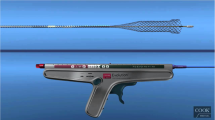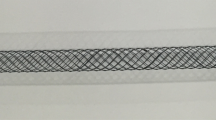Abstract
Background and Aim
Obstructive jaundice caused by distal biliary obstruction can present in up to 70 % of patients with localized cancer of the head of the pancreas. The aim of this study was to report our experience in using self-expanding metal stents (SEMS) for preoperative biliary decompression in patients with resectable and borderline resectable carcinoma of the pancreatic head.
Methods
We performed a retrospective study evaluating patients from two tertiary referral centers. Two-hundred and forty-one patients with resectable and borderline resectable pancreatic carcinoma underwent ERCP with metal biliary stent placement between September 2006 and August 2011. We assessed the effectiveness of SEMS to adequately decompress the biliary tree, procedural success, patient survival, stent patency, and stent-related complications.
Results
Two-hundred and forty-one patients were evaluated [123 male, mean age (±SD) 67.4 ± 9.8 years; resectable 174, borderline resectable 67]. Patients with borderline-resectable cancer underwent neoadjuvant therapy and restaging before possible curative surgery. Successful placement of a metal biliary stent was achieved in all patients and improved jaundice. Patients were followed for mean duration of 6.3 months. The overall survival was 49 % at 27 months. Fourteen (5.8 %) patients experienced stent occlusion; the mean time to stent occlusion was 6.6 (range 1–20) months. Immediate complications included: post-ERCP pancreatitis (n = 14), stent migration (n = 3), and duodenal perforation (n = 3). Long-term complications included stent migration (n = 9) and hepatic abscess (n = 1). A total of 144/174 patients deemed to have resectable cancer at time of diagnosis underwent curative surgery. Due to disease progression or the discovery of metastasis after neoadjuvant therapy, only 22/67 patients with borderline-resectable cancer underwent curative surgery.
Conclusions
SEMS should be considered for patients with obstructive jaundice and resectable or borderline resectable pancreatic cancer, especially if surgery is not planned immediately as a result of preoperative chemoradiation. These stents appear to be safe and effective.


Similar content being viewed by others
References
Siegel R, Naishadham D, Jemal A. Cancer statistics, 2012. CA Cancer J Clin. 2012;62:10–29.
Guidelines for the management of patients with pancreatic cancer periampullary and ampullary carcinomas. Gut. 2005;54:v1–v16.
Lowy AM. Neoadjuvant therapy for pancreatic cancer. J Gastrointest Surg. 2008;12:1600–1608.
Greer SE, Pipas JM, Sutton JE, et al. Effect of neoadjuvant therapy on local recurrence after resection of pancreatic adenocarcinoma. J Am Coll Surg. 2008;206:451–457.
Katz MH, Pisters PW, Evans DB, et al. Borderline resectable pancreatic cancer: the importance of this emerging stage of disease. J Am Coll Surg. 2008;206:833–846.
van der Gaag NA, Kloek JJ, de Castro SM, Busch OR, van Gulik TM, Gouma DJ. Preoperative biliary drainage in patients with obstructive jaundice: history and current status. J Gastrointest Surg. 2009;13:814–820.
Klinkenbijl JH, Jeekel J, Schmitz PI, et al. Carcinoma of the pancreas and periampullary region: palliation versus cure. Br J Surg. 1993;80:1575–1578.
Lillemoe KD. Preoperative biliary drainage and surgical outcome. Ann Surg. 1999;230:143–144.
Sewnath ME, Birjmohun RS, Rauws EA, Huibregtse K, Obertop H, Gouma DJ. The effect of preoperative biliary drainage on postoperative complications after pancreaticoduodenectomy. J Am Coll Surg. 2001;192:726–734.
Vakil N, Gross U, Bethge N. Human tissue responses to metal stents. Gastrointest Endosc Clin N Am. 1999;9:359–365.
Reed DN Jr, Vitale GC. Interventional endoscopic retrograde cholangiopancreatography and endoscopic surgery. Surg Clin N Am. 2000;80:1171–1201.
van der Gaag NA, Rauws EA, van Eijck CH, et al. Preoperative biliary drainage for cancer of the head of the pancreas. N Engl J Med. 2010;362:129–137.
Aadam AA, Evans DB, Khan A, Oh Y, Dua K. Efficacy and safety of self-expandable metal stents for biliary decompression in patients receiving neoadjuvant therapy for pancreatic cancer: a prospective study. Gastrointest Endosc. 2012;76(1):67–75.
Jessup JM, Steele G Jr, Mayer RJ, et al. Neoadjuvant therapy for unresectable pancreatic adenocarcinoma. Arch Surg. 1993;128:559–564.
Barugola G, Partelli S, Crippa S, et al. Outcomes after resection of locally advanced or borderline resectable pancreatic cancer after neoadjuvant therapy. Am J Surg. 2012;203:132–139.
McClaine RJ, Lowy AM, Sussman JJ, Schmulewitz N, Grisell DL, Ahmad SA. Neoadjuvant therapy may lead to successful surgical resection and improved survival in patients with borderline resectable pancreatic cancer. HPB (Oxf). 2010;12:73–79.
NCCN practice guidelines for pancreatic cancer. Oncology (Williston Park). 1997;11:4–55.
Fogelman DR, Chen J, Chabot JA, et al. The evolution of adjuvant and neoadjuvant chemotherapy and radiation for advanced pancreatic cancer: from 5-fluorouracil to GTX. Surg Oncol Clin N Am. 2004;13:711–735.
Ng J, Zhang C, Gidea-Addeo D, Saif MW. Locally advanced pancreatic adenocarcinoma: update and progress. JOP. 2012;13:155–158.
Karsten TM, Allema JH, Reinders M, et al. Preoperative biliary drainage, colonisation of bile and postoperative complications in patients with tumours of the pancreatic head: a retrospective analysis of 241 consecutive patients. Eur J Surg. 1996;162:881–888.
Mueller PR, Ferrucci JT Jr, Teplick SK, et al. Biliary stent endoprosthesis: analysis of complications in 113 patients. Radiology. 1985;156:637–639.
Abrams RA, Lowy AM, O’Reilly EM, Wolff RA, Picozzi VJ, Pisters PW. Combined modality treatment of resectable and borderline resectable pancreas cancer: expert consensus statement. Ann Surg Oncol. 2009;16:1751–1756.
Spitz FR, Abbruzzese JL, Lee JE, et al. Preoperative and postoperative chemoradiation strategies in patients treated with pancreaticoduodenectomy for adenocarcinoma of the pancreas. J Clin Oncol. 1997;15:928–937.
Siddiqui AA, Mehendiratta V, Loren D, Hong SK, Kowalski T. Fully covered self-expandable metal stents are effective and safe to treat distal malignant biliary strictures, irrespective of surgical resectability status. J Clin Gastroenterol. 2011;45:824–827.
Wasan SM, Ross WA, Staerkel GA, Lee JH. Use of expandable metallic biliary stents in resectable pancreatic cancer. Am J Gastroenterol. 2005;100:2056–2061.
Decker C, Christein JD, Phadnis MA, Wilcox CM, Varadarajulu S. Biliary metal stents are superior to plastic stents for preoperative biliary decompression in pancreatic cancer. Surg Endosc. 2011;25:2364–2367.
Ayaru L, Kurzawinski TR, Shankar A, Webster GJ, Hatfield AR, Pereira SP. Complications and diagnostic difficulties arising from biliary self-expanding metal stent insertion before definitive histological diagnosis. J Gastroenterol Hepatol. 2008;23:315–320.
Mullen JT, Lee JH, Gomez HF, et al. Pancreaticoduodenectomy after placement of endobiliary metal stents. J Gastrointest Surg. 2005;9:1094–1104.
Nakai Y, Isayama H, Komatsu Y, et al. Efficacy and safety of the covered Wallstent in patients with distal malignant biliary obstruction. Gastrointest Endosc. 2005;62:742–748.
Kahaleh M, Tokar J, Conaway MR, et al. Efficacy and complications of covered Wallstents in malignant distal biliary obstruction. Gastrointest Endosc. 2005;61:528–533.
Ornellas LC, Stefanidis G, Chuttani R, Gelrud A, Kelleher TB, Pleskow DK. Covered Wallstents for palliation of malignant biliary obstruction: primary stent placement versus reintervention. Gastrointest Endosc. 2009;70:676–683.
Isayama H, Komatsu Y, Tsujino T, et al. Polyurethane-covered metal stent for management of distal malignant biliary obstruction. Gastrointest Endosc. 2002;55:366–370.
Acknowledgments
This study was funded entirely through existing intramural funds and salary support.
Conflict of interest
Drs. Siddiqui, Mehendiratta, Loren, and Kowalski are consultans to Boston Scientific and Cook Endoscopy. Drs. Adler and Fang are consultants to Boston Scientific and Merit.
Author information
Authors and Affiliations
Corresponding author
Rights and permissions
About this article
Cite this article
Siddiqui, A.A., Mehendiratta, V., Loren, D. et al. Self-Expanding Metal Stents (SEMS) for Preoperative Biliary Decompression in Patients with Resectable and Borderline-Resectable Pancreatic Cancer: Outcomes in 241 Patients. Dig Dis Sci 58, 1744–1750 (2013). https://doi.org/10.1007/s10620-012-2482-z
Received:
Accepted:
Published:
Issue Date:
DOI: https://doi.org/10.1007/s10620-012-2482-z




